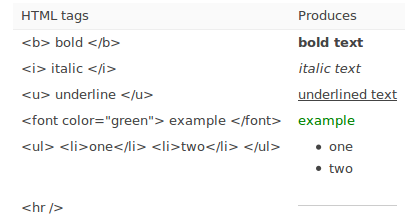Formatting text: Difference between revisions
m (→Markdown text format: SPACE after .) |
Helen Foster (talk | contribs) (→Moodle auto-format: smilies and html tags copied from help file) |
||
| Line 10: | Line 10: | ||
When you save your text, Moodle will do a number of things to automatically format your text for you. | When you save your text, Moodle will do a number of things to automatically format your text for you. | ||
Anything starting with www. or http:// will automatically be turned into a clickable link, for example [http://www.moodle.org www.moodle.org]. | |||
Your line breaks will be retained, and blank lines will start new paragraphs. | |||
Smiley characters such as :-) will automatically become their graphical equivalents. | Smiley characters such as :-) will automatically become their graphical equivalents. | ||
[[Image:Smilies.png]] | |||
You can even embed HTML code if you want to and it will be retained. | You can even embed HTML code if you want to and it will be retained. | ||
[[Image:Html tags.png]] | |||
==HTML format== | ==HTML format== | ||
Revision as of 10:44, 18 May 2010
When writing text in Moodle there are several formats you can choose to produce your text, depending on your expertise and the type of browser you are using.
Usually you can just leave this setting to the default value and things should work as you expect.
Moodle auto-format
This format is best for when you are using normal web forms for entry (instead of the Richtext HTML editor). Just type text normally, as if you were sending an email.
When you save your text, Moodle will do a number of things to automatically format your text for you.
Anything starting with www. or http:// will automatically be turned into a clickable link, for example www.moodle.org.
Your line breaks will be retained, and blank lines will start new paragraphs.
Smiley characters such as :-) will automatically become their graphical equivalents.
You can even embed HTML code if you want to and it will be retained.
HTML format
This format assumes the text is pure HTML. If you are using the HTML editor to edit text then this is the default format - all the commands in the toolbar are producing HTML for you.
Even if you are not using the Richtext HTML editor, you can use HTML code in your text and it should come out exactly as you intended.
Unlike the Moodle auto-format, no automatic formatting is performed.
More info about HTML in Moodle: http://moodle.org/help.php?file=html.html
More info about the Richtext HTML editor: http://moodle.org/help.php?file=richtext.html
Plain text format
This format is useful when you need to include lots of code or HTML that you want to be displayed exactly as you wrote it.
It still translates spaces and new lines, but otherwise your text isn't touched.
Markdown text format
Markdown format tries to make it easy as possible to type well-formatted XHTML pages using nothing but text written more or less like you would write an email.
It's very good for writing clean text pages with some headings and some lists but without many links or images. It is an excellent choice when accessibility of the generated page is important.
For complete syntax description, see: http://daringfireball.net/projects/markdown/syntax Moodle 1.6 has extended features called Markdown Extra: for additional features see http://www.michelf.com/projects/php-markdown/extra/
Tips and Tricks
- Wrong Characters Showing - If some users do not see the same characters or figures, have them check their browser settings for their character settings. At Moodle.org, the recommended default character decoding set is UTF-8. On a Firefox browser, this can be found in Tools>Options>Fonts & colors>advanced>default character decoding pull down menu.
If that doesn't work you can try installing a UTF-8 Unicode font from: http://titus.fkidg1.uni-frankfurt.de/unicode/tituut.asp. (This has at least helped XP users that weren't seeing stars in the ratings.)

